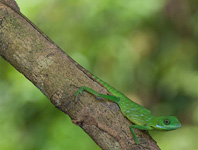Abstract
The colubrid snake genus Tantilla currently comprises 62 valid species distributed from the southern United States of America to southern Bolivia in the west, and Uruguay and northern Argentina in the east (Wilson & Mata-Silva 2014, 2015). Of these 62 species, 13 are found in South America (Wilson & Mata-Silva 2014, 2015). The most recently described of these Southamerican species is Tantilla marcovani Lema, 2004. While we were working on a checklist and key to the members of the Tantilla clade (sensu Holm 2008, including the genera Geagras Cope 1876, Scolecophis Fitzinger 1843, Tantilla Baird & Girard 1853, and Tantillita Smith 1941; Wilson & Mata-Silva 2015), it became apparent that the diagnosis of T. marcovani entirely falls to distinguish this nominal taxon from the widespread and extensively variable T. melanocephala Linnaeus 1758. Tantilla melanocephala, as presently envisioned, is the most broadly distributed member of its genus (Wilson & Mena 1980; Savage 2002; Greenbaum et al. 2004), occurring from Panama southward into the major portion of the South American continent, apart from Chile and southern Argentina.
References
Freitas, M.A. & Silva, T.F.S. (2007) Guia Ilustrado: a Herpetofauna das Caatingas e Áreas de Altitudes do Nordeste Brasileiro. Editora USEB, Pelotas, 384 pp.
Greenbaum, E., Carr, J.L. & Almendáriz, A. (2004) Taxonomic status of Tantilla equatoriana Wilson and Mena 1980 (Serpentes: Colubridae). The Southwestern Naturalist, 49 (4), 457–464.
http://dx.doi.org/10.1894/0038-4909(2004)049%3C0457:TSOTEW%3E2.0.CO;2
Guedes, T.B., Nogueira, C. & Marques, O.A.V. (2014) Diversity, natural history, and geographic distribution of snakes in the Caatinga, Northeastern Brazil. Zootaxa, 3863 (1), 1–93.
http://dx.doi.org/10.11646/zootaxa.3863.1.1
Hamdan, B. & Lira-da-Silva, R.M. (2012) The snakes of Bahia State, northeastern Brazil: species richness, composition and biogeographical notes. Salamandra, 48 (31), 31–50.
Holm, P.A. (2008) Phylogenetic biology of the burrowing snake tribe Sonorini (Colubridae). Unpublished dissertation, University of Arizona, Tucson, 240 pp.
Lema, T. (2004) New species of Tantilla Baird & Girard from northeastern Brazil (Serpentes, Colubrinae). Acta Biologica Leopoldensia, 26 (2), 267–284.
Savage, J.M. (2002) The Amphibians and Reptiles of Costa Rica: A Herpetofauna between Two Continents, between Two Seas. The University of Chicago Press, Illinois, 954 pp.
Wilson, L.D. & Mata-Silva, V. (2014) Snakes of the genus Tantilla (Squamata: Colubridae) in Mexico: taxonomy, distribution, and conservation. Mesoamerican Herpetology, 1 (1), 1–95.
Wilson, L.D. & Mata-Silva, V. (2015) A checklist to the snakes of the Tantilla clade (Squamata: Colubridae), with comments on taxonomy, distribution, and conservation. Mesoamerican Herpetology, 2 (4), 418–498.
Wilson, L.D. & Mena, C.E. (1980) Systematics of the melanocephala group of the colubrid snake genus Tantilla. San Diego Society of Natural History Memoir, II, 1–58.

